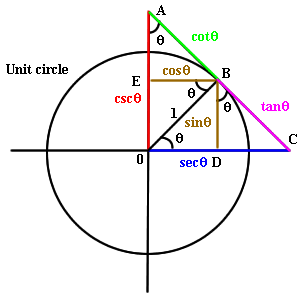- A = [xA, yA] is a point on the 2D plane. Same for B, C, ...
- lengths are in any unit (ex: pixels)
- code snippets are in JavaScript
angleRad = angleDeg * Math.PI / 180;
angleDeg = angleRad * 180 / Math.PI;
- dist = function(A,B){ return Math.sqrt((xB - xA)*(xB - xA) + (yB - yA)*(yB - yA)) } // ES5
- dist = (A, B) => Math.hypot(xB - xA, yB - yA) // ES6
- line equation: y = ax + b
- a = (yB - yA) / (xB - xA) = tan θ
- θ = angle between line and x axis
- b = yA - a * xA (because yA = a * xA + b)
- line 1: y = a * x + b
- line 2: y' = a' * x + b'
- intersection point P:
- xP = (a - a')/(b' - b);
- yP = a * xP + b;
- Ex with y = 5 * x + 1 and y' = 2 * x + 8:
- xP = 7/3;
- yP = 12.666;
angle = Math.atan2(Ax, Ay)
angle = Math.atan2(By - Ay, Bx - Ax);
- Anew_x = Ax * Math.cos(angle) - Ay * Math.sin(angle)
- Anew_y = Ax * Math.sin(angle) + Ay * Math.cos(angle)
- It's the same as applying the following rotation matrix:
vec2 (
+cos(a), -sin(a)
+sin(a), +cos(a)
)
ES5:
Anew_x = Math.cos(atan2(Ax, Ay));
Anew_y = Math.sin(atan2(Ax, Ay));
ES6:
tmp = Math.hypot(Ax, Ay);
Ax = Ax / tmp;
Ay = Ay / tmp;
- http://www.cse.yorku.ca/~amana/research/grid.pdf
- http://en.wikipedia.org/wiki/Bresenham%27s_line_algorithm
- Demo by xem: http://codepen.io/xem/pen/RRxPNG?editors=1010
- new_y = Math.sin(-y * Math.PI/2);
- new_x = Math.sin(x * Math.PI) * Math.cos(y * Math.PI / 2);
- if Math.abs(x) < .5, the projected point is hidden "behind" the sphere.
- Prototype by subzey: http://codepen.io/subzey/pen/rVoXQx
- Demo by xem (on a 2D canvas): http://xem.github.io/articles/demos/js13k15/globe2.html
- let x, y the position of the object (ex: 0, 0)
- let vx, vy the horizontal and vertical speed of the object (ex: 0, 0)
- let g, the gravity (which is a downwards acceleration, ex: -10)
- during the frame at the start of the jump: set vy to a high value, ex: 50
- during all the frames of the jump:
- Add g to vy (ex: 40, 30, 20, 10, 0, -10, ...)
- Add vy to y (ex: 40, 70, 90, 100, 100, 90, ...)
- place the object at [x,y]
Also applicable to all kind of accelerations in x or y directions.
Use time instead of frames to make the animation. Demo: https://jsfiddle.net/subzey/p1ftrar0/
- line: a * x + b * y + c = 0
- point: xA, yA
- distance: d = Math.abs(a * xA + b * yA + c) / Math.sqrt(a * a + b * b)
lerpDeg = function(start,end,amt){
ver dif=end-start;
dif = dif%360;
if(dif>180.0) {
dif-=360.0;
}
else if (dif<-180.0) {
dif+=360.0;
}
return start+dif*amt;
}
In order to create a 3d rotation, just take the idenity matrix:
vec3 (
1, 0, 0,
0, 1, 0,
0, 0, 1
)
And fill in the sines and cosines:
vec3 (
+cos(a), -sin(a), 0,
+sin(a), +cos(a), 0,
0 , 0 , 1
) // Rotation in XY plane
vec3 (
+cos(a), 0, -sin(a),
0 , 1, 0 ,
+sin(a), 0, +cos(a)
) // Rotation in XZ plane
vec3 (
1, 0 , 0 ,
0, +cos(a), -sin(a),
0, +sin(a), +cos(a)
) // Rotation in YZ plane
y' = y*cos(a) - z*sin(a)
z' = y*sin(a) + z*cos(a)
x' = x
z' = z*cos(a) - x*sin(a)
x' = z*sin(a) + x*cos(a)
y' = y
x' = x*cos(a) - y*sin(a)
y' = x*sin(a) + y*cos(a)
z' = z
x' = x * fov / (z + viewer_distance) + half_screen_width
y' = -y * fov / (z + viewer_distance) + half_screen_height
(no z)
https://www.youtube.com/playlist?list=PLZHQObOWTQDPD3MizzM2xVFitgF8hE_ab
ftp://rtfm.mit.edu/pub/usenet-by-group/news.answers/graphics/algorithms-faq
(from https://gist.github.com/gre/1650294)
/*
* Easing Functions - inspired from http://gizma.com/easing/
* only considering the t value for the range [0, 1] => [0, 1]
*/
EasingFunctions = {
// no easing, no acceleration
linear: function (t) { return t },
// accelerating from zero velocity
easeInQuad: function (t) { return t*t },
// decelerating to zero velocity
easeOutQuad: function (t) { return t*(2-t) },
// acceleration until halfway, then deceleration
easeInOutQuad: function (t) { return t<.5 ? 2*t*t : -1+(4-2*t)*t },
// accelerating from zero velocity
easeInCubic: function (t) { return t*t*t },
// decelerating to zero velocity
easeOutCubic: function (t) { return (--t)*t*t+1 },
// acceleration until halfway, then deceleration
easeInOutCubic: function (t) { return t<.5 ? 4*t*t*t : (t-1)*(2*t-2)*(2*t-2)+1 },
// accelerating from zero velocity
easeInQuart: function (t) { return t*t*t*t },
// decelerating to zero velocity
easeOutQuart: function (t) { return 1-(--t)*t*t*t },
// acceleration until halfway, then deceleration
easeInOutQuart: function (t) { return t<.5 ? 8*t*t*t*t : 1-8*(--t)*t*t*t },
// accelerating from zero velocity
easeInQuint: function (t) { return t*t*t*t*t },
// decelerating to zero velocity
easeOutQuint: function (t) { return 1+(--t)*t*t*t*t },
// acceleration until halfway, then deceleration
easeInOutQuint: function (t) { return t<.5 ? 16*t*t*t*t*t : 1+16*(--t)*t*t*t*t }
}
(from https://twitter.com/MaximeEuziere/status/1047545802669875200 )
V=(x,y)=>({x,y}) // Vec2D constructor
l=v=>d(v,v)**.5 // length(v)
a=(v,w)=>V(v.x+w.x,v.y+w.y) // add(v, w)
s=(v,w)=>a(v,m(w,-1)) // sub(v, w)
m=(v,n)=>V(v.x*n,v.y*n) // scale(v, n)
t=(v,w)=>l(s(v,w)) // distance(v, w)
d=(v,w)=>v.x*w.x+v.y*w.y // dot_product(v, w)
c=(v,w)=>v.x*w.y-v.y*w.x // cross_product(v, w)
r=(v,o,t)=>a(o,V(c(f=s(v,o),g=V(Math.sin(t),Math.cos(t))),d(f,g))) // rotate(v, origin, theta_angle)
n=v=>m(v,1/(l(v)||1)) // normalize(v)

better to also have a "rotation along arbitrary axis", length being radians to rotate, no singularity at zero.
even more, somehow in favor of quaternion "slerp" because i think quaternion describes "state" or "instant transformation" but not the dynamic, continuous "rotation".
for reference and free copy: http://farter.cn/math/rotvec3/